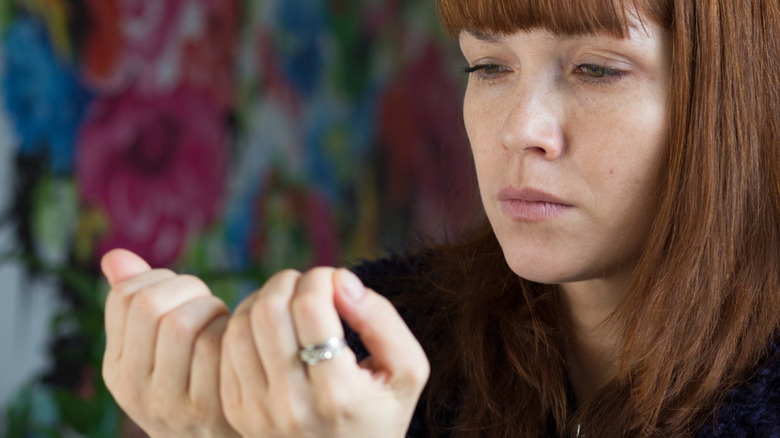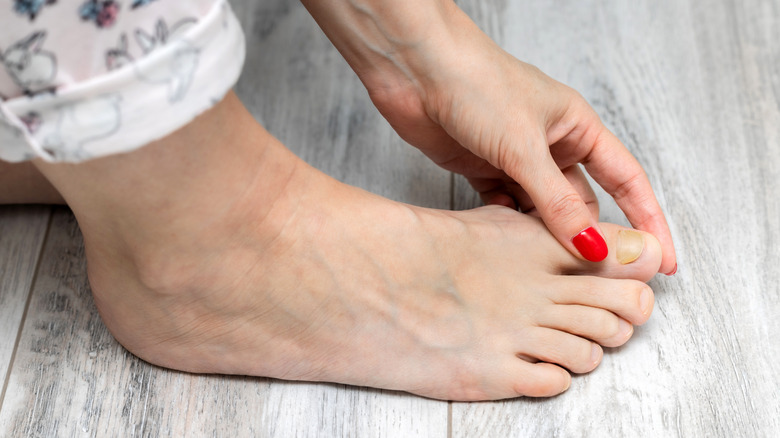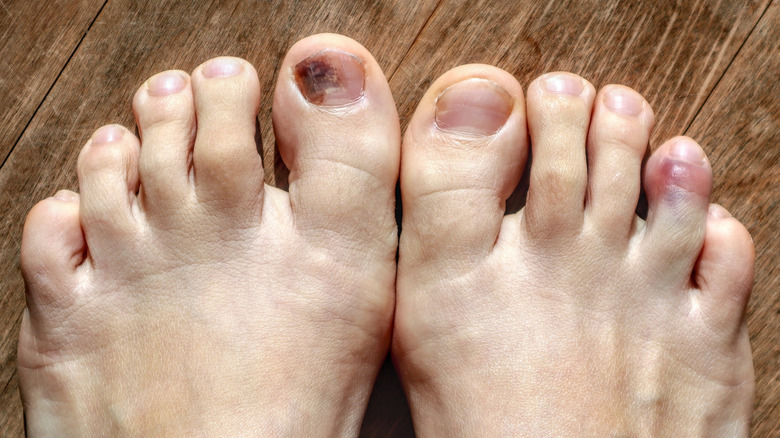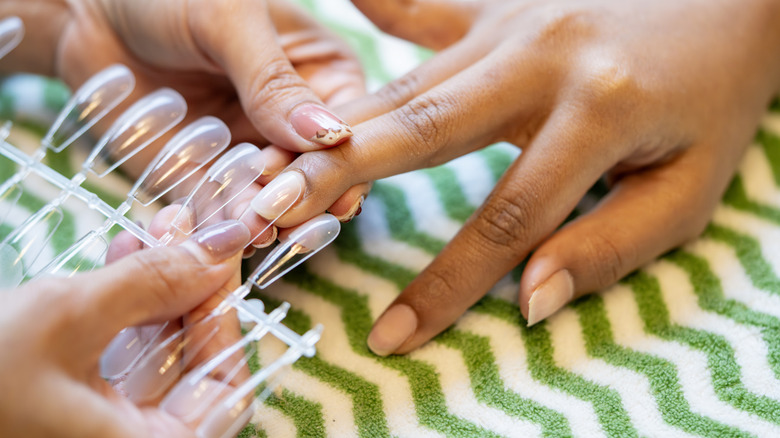What It Really Means If Your Nails Change Color
Turning your fingernails and toenails into vibrant works of art can showcase your style and personality. But what happens when your nails change color on their own? In that case, you might wonder if you have a serious medical problem.
Fortunately, nail discoloration is frequently unsightly but not a reason to contact your doctor immediately. That said, you should pay attention to any unexpected nail changes. As dermatologist Dr. Dawn Davis explained in an article for the Mayo Clinic, "Your nails are part of your skin. They are made up of layers of the protein keratin and grow from beneath the base of the nail under your cuticle." In fact, she noted that the fingernails can be an indicator of your overall health, meaning that you might want to pay attention when they look strange. (Read about some health secrets your nails are trying to tell you.)
What are your nails attempting to say when they take on abnormal tints? It depends on the color, so let's roll through a rainbow of answers, starting with red.
Decoding the meaning behind red nails
If you notice tiny red lines under your nails, they're probably splinter hemorrhages. Splinter hemorrhages are red and black spots that show up on your fingernails when the blood vessels under your nail bed burst. For instance, if you drop a gallon of ice cream on your little toe, you may cause enough trauma to elicit splinter hemorrhages. (This isn't as scary as it sounds; they're just there because the blood dries before it can escape.)
You could get splinter hemorrhages for other reasons, such as if you have psoriasis. In fact, a 2017 article in Reumatologia notes that up to 90% of people with psoriasis of the skin can get psoriasis of the nails. And splinter hemorrhages are a telltale sign of nail psoriasis.
There's one circumstance where splinter hemorrhages may warrant medical intervention, and that's if they're accompanied by side effects of known or suspected heart disease. As the American Academy of Dermatology Association explains, splinter hemorrhages can indicate the presence of heart issues when coupled with other signs of cardiovascular concerns like an elevated temperature or abnormal heartbeat.
Conditions and habits hiding behind yellow nails
Next up on the list of medically related unusual nail colors: yellow. Fungal infections are a common reason for nails to turn yellowish or brown. (Read about the difference between toenail fungus and athlete's foot.) The standard cure for yellowed nails that have been discolored due to a fungal infection is treatment with medication, laser therapy, or ointments.
Like nails with reddish splinter hemorrhages, yellowed nails can indicate the possibility of more serious conditions as well. For example, individuals who have been diagnosed with thyroid issues, emphysema, and rheumatoid arthritis may have yellow nails.
On the other hand, lifestyle habits — including both unhealthy and healthy ones — could be the underlying reason for your yellow nails. Take smoking. Frequently, nicotine will stain a smoker's fingernails and tips of their fingers, turning them a dark yellow shade. Accordingly, if you smoke and your fingernails are yellow, you may want to treat it as a sign to quit.
Of course, a less concerning (and tasty) reason for yellow nails is that you've been making a dish using turmeric, which can turn all parts of your hands yellow. Turmeric offers some decent health benefits, so your spice-stained nails can be an indication of your dedication to a healthier diet. (Here's what happens when you take turmeric every day.)
Interpreting the causes of blue and green nails
If your nails turn green or blue-green, you may have a condition that's fittingly called green nail syndrome. A buildup of a certain type of bacteria causes green nail syndrome, which may be unsightly but isn't generally uncomfortable. (You can see it but won't feel it.) To get rid of green nail syndrome, you may have to apply topical antibiotic treatments for up to four months, in addition to taking a course of ingested antibiotics if the bacteria remains unaffected by the healing cream.
Green nails can also indicate that you've bruised the area under your nail. In medical terms, that would be called a subungual hematoma. Again, let's say you let a family-sized box of frozen hamburgers fall on your foot. If it struck one of your toes, you might end up nursing a green nail. (Here's how to tell the difference between nail mold and fungus.)
Waking up to a nail that's purple
Another nail shade that looks odd is purple (or even black). Once again, purple is frequently a sign of trauma. Yet you don't have to actually hit your nail for trauma to occur.
For instance, if you're an athlete, you know that being on your feet for hours (e.g., in a race, during a game) can put pressure on your toes and toenails. In a Cleveland Clinic interview, podiatrist Dr. Georgeanne Botek outlined why intense activity can cause discoloration beneath your nail bed: "The black or dark color you see under your toenail may be bruising or blood."
But when your nails turn purple or black, you may also be having other problems, like poor circulation that affects your whole system. If that's the situation, you'll likely notice that other parts of your body (like your hands, toes, or arms) may be turning blue or purple, too. Getting seen by a provider is important because this condition, cyanosis, can be serious and indicate that your heart, lungs, or blood aren't working adequately.
Some skin cancers can show up as purple or black spots under your nail. In speaking with Men's Health, dermatologist Dr. Shari Lipner explained that "if your nail is brown or black, the most important thing to worry about is a nail melanoma." Since melanoma can be fatal if it's allowed to spread, get evaluated if your nail (and perhaps the surrounding skin) turns dark purple, brownish, or black.
When your nails become oddly white
Rounding out the palette of potential nail colors is white. Completely or partially white nails are called leukonychia. Though parts of your nail (such as the cuticle or tip) may be white naturally, an all-white nail or a fingernails with many white spots may be a sign of the presence of lupus or another disease.
In most situations, white spots in the nail are not serious and could have surprisingly unexciting origins. For instance, a 2022 review in the American Journal of Clinical Dermatology notes that getting artificial nails can cause nails to turn white in spots. Consequently, if you've been a fan of putting nails on and taking them off again for a while, you might see white areas on your real nails.
Essentially, you should treat nail discoloration like any other unexplained bodily occurrence: Initially, be on the lookout for other medical indications. But resist the temptation to think that every red streak or blue splotch means your health is at risk.





